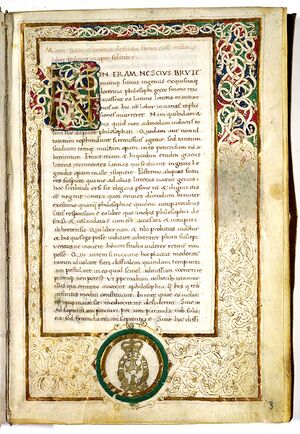عن نهايات الخير والشر
 عن نهايات الخير والشر | |
| المؤلف | شيشرون |
|---|---|
| البلد | الجمهورية الرومانية |
| اللغة | اللاتينية الكلاسيكية |
| الموضوع | الأخلاقيات |
| الصنف | فلسفة، حوار |
تاريخ النشر | 45 ق.م. |
| سبقه | الأكاديمي |
عن نهايات الخير والشر (باللاتينية: De finibus bonorum et malorum)، هو حوار سقراطي للخطيب والسياسي والفيلسوف الشكوكي الأكاديمي الروماني شيشرون. يتالف من ثلاث حوارات، ضمن خمسة كتب، يناقش فيها شيشرون الآراء الفلسفية حول الإپيقورية، الرواقية، وأفلاطونية أنطيوخس العسقلاني الذي يؤيد نظامًا هجينًا من الأفلاطونية والأرسطية (التي يعتبرها تقليدًا واحدًا "الأكاديمية القديمة"). كُتبت الرسالة بحيث يتم وصف كل نظام فلسفي في كتابه الخاص، ومن ثم الطعن فيه في الكتاب التالي (باستثناء وجهة نظر أنطيوخس التي تم شرحها والمتنازع عليها في الكتاب الخامس). تطور الكتاب في صيف عام 45 ق.م، وكُتب على مدار شهر ونصف تقريبًا. جنبًا إلى جنب مع نزاعات توسكولوم المكتوب بعد ذلك بوقت قصير و'الأكاديمي، يُعد كتاب عن نهايات الخير والشر واحدًا من أكثر الأعمال الفلسفية شمولاً التي كتبها شيشرون. أهدى شيشرون الكتاب لماركوس جونيوس بورتس.
المحتويات
الكتابان الأول والثاني
The first two books are a dialogue set at Cicero's country home in Cumae between himself and a young Epicurean named Lucius Torquatus, while another young Roman named Gaius Triarius listens on. In the first book, the interlocutors present the Epicurean theory of hedonism, which holds that pleasure in the form of aponia (absence of pain) is regarded as the highest good. In the second book, Cicero criticizes this view, attacking the Epicurean definition of pleasure and arguing that it is inconsistent to hold pleasure as the absence of pain as the final good, since these are not one single good, but rather two distinct goods.
الكتابات الثالث والرابع
In the next two books, Stoic ethics are discussed. In the third book, Cicero's interlocutor, Marcus Porcius Cato, presents Stoic doctrine. Here, Cicero introduces the technical terms used by the Stoics into Latin. The highest and only good of the Stoics is virtue (moral good). In the fourth book, Cicero casts doubt on this dogma, arguing a supposed natural state (the "cradle argument"), as well as issues regarding the exclusion of other goods entailed by Stoic doctrine.
الكتاب الخامس
In the last book, Cicero presents in the form of a dialogue between himself and several friends the theory of eudaimonia taught by Antiochus of Ascalon, which treats Aristotelianism as a subgroup of Platonism. This theory includes both virtue and external goods as the highest good. At the end of the book, Cicero criticized logical inconsistencies of this teaching, but more briefly and only addressing details, not broader principles. Cicero then declares that he follows this school of thought, albeit not without reservations, while respecting the valuable aspects of the teachings presented in the previous books.
الذكرى
In graphic design, Lorem ipsum, a commonly used placeholder text, is based on De finibus. The placeholder text is taken from parts of the first book's discourse on Epicureanism. Words of the original text have been altered, added, and removed in Lorem ipsum to make it nonsensical, improper Latin.
انظر ايضاً
قراءات إضافية
- Annas, Julia Elisabeth; Betegh, Gábor (2016). Cicero's "De finibus": philosophical approaches. Cambridge: Cambridge university press. ISBN 9781107074835.
وصلات خارجية
- De finibus bonorum et malorum, Latin text
- De Finibus, English translation by Harris Rackham, LacusCurtius
- Side by Side Latin and English, transl. by Harris Rackham, Google Books
- قالب:Librivox book

